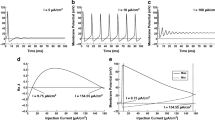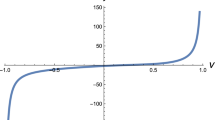Abstract
FORGACS1 has described experiments which led to the conclusion that steady-state flow may not occur during ion transport through ion-selective membranes. His observations may be summarized as follows. Constant direct current (from rectified power supply or accumulators) was passed through the cell:  where M is a homogeneous cation or anion exchange membrane. The solutions were stirred at 1,100 r.p.m. Saturated calomel probe electrodes connected through 0.01 M potassium chloride/0.01 M potassium nitrate salt bridges to an oscilloscope were used to measure potential differences across the membrane. It was found that: (1) the observed potential underwent anharmonic oscillation (frequency not stated) about a constant average value; (2) the peak-to-peak amplitude of the oscillations increased with increasing current density; (3) similar oscillations of smaller amplitude were observed when the membrane was removed; (4) similar oscillations of much greater amplitude were observed when the solutions were replaced with 0.01 M silver nitrate in an agar gel.
where M is a homogeneous cation or anion exchange membrane. The solutions were stirred at 1,100 r.p.m. Saturated calomel probe electrodes connected through 0.01 M potassium chloride/0.01 M potassium nitrate salt bridges to an oscilloscope were used to measure potential differences across the membrane. It was found that: (1) the observed potential underwent anharmonic oscillation (frequency not stated) about a constant average value; (2) the peak-to-peak amplitude of the oscillations increased with increasing current density; (3) similar oscillations of smaller amplitude were observed when the membrane was removed; (4) similar oscillations of much greater amplitude were observed when the solutions were replaced with 0.01 M silver nitrate in an agar gel.
Similar content being viewed by others
References
Forgacs, C., Nature, 190, 339 (1961).
Author information
Authors and Affiliations
Rights and permissions
About this article
Cite this article
LORIMER, J., BRYDGES, T. Anharmonic Oscillations in Electrical Potential at Probe Electrodes in Membrane Transport Cells. Nature 209, 1019–1020 (1966). https://doi.org/10.1038/2091019a0
Issue Date:
DOI: https://doi.org/10.1038/2091019a0
- Springer Nature Limited





